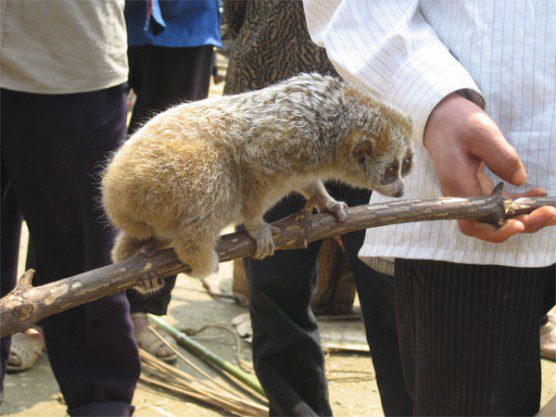Poisonous primates?

We’ve all heard about venomous snakes, frogs, and spiders, but what about primates?
Venomous mammals are fairly rare. There are some shrews and shrew-like animals, and the male duck-billed platypus has a spur on his hind leg that can deliver a painfully toxic punch. But the primate order has a few species, too, that produce and use noxious chemicals.
Slow lorises (as many as five species are now recognized, all native to South and Southeast Asia) are said to be venomous. By some definitions, a “venom” is a kind of toxin delivered by injection, with the poison-producing gland attached to the delivery mechanism.
According to the Loris Conservation Database, “Loris bites are painful and often heal slowly because of bacterial flora on the teeth; severe disease and death of humans due to the effect of a poison produced in loris… skin glands have been reported.”
Lorises produce a secretion from brachial glands on the insides of their arms. The animals lick this secretion and spread it over their bodies. Their saliva apparently causes inhibitors in the secretion to break down, resulting in a toxic compound. Lorises are then able to inject this substance into their victim when they bite. It’s been said that these small, slow-moving, nocturnal primates use this method for defense against predators.
Interestingly, part of the loris secretion appears to be chemically related to one of the allergens produced by cats. This would explain how, if you are unfortunate enough to be bitten by a slow loris, you may risk going into anaphylactic shock, especially if you’re allergic to cats.
So maybe lorises are not technically venomous, in the same sense that a cobra or a platypus is. But the nasty secretion they produce is nothing to dismiss.
Which explains why a cat makes a great pet, but a slow loris doesn’t.

A slow loris for sale in an Indonesian market. Despite the potential to deliver a toxic bite, these primates are sought after as pets.
Strangely, even though lorises can deliver a potentially dangerous bite, these little animals are popular in the pet trade, especially in Southeast Asia. Cute and cuddly looking, they are bought as a kind of “living toy.” Traders brutally remove or cut off the animals’ sharp teeth to prevent them from delivering a nasty bite to their customers. Lorises who are rescued from this miserable trade often die because of dental infections.
In fact, lorises are captured so frequently that many conservationists are becoming alarmed about their declining numbers in the wild. To combat this trend, our friends at the Little Fireface Project are working to promote loris conservation through ecological research and public education.
Dr. Anna Nekaris and her team regularly go into the field armed with GPS units and special red lights for tracking the nocturnal animals. With the support of IPPL, Indonesian students are also being trained to carry out observations of the animals in their native habitat. The team members of the Little Fireface Project are also working on market surveys and law enforcement training initiatives. It would be a shame to lose these unique “poisonous primates” before we even have a chance to unravel their mysterious ways.

